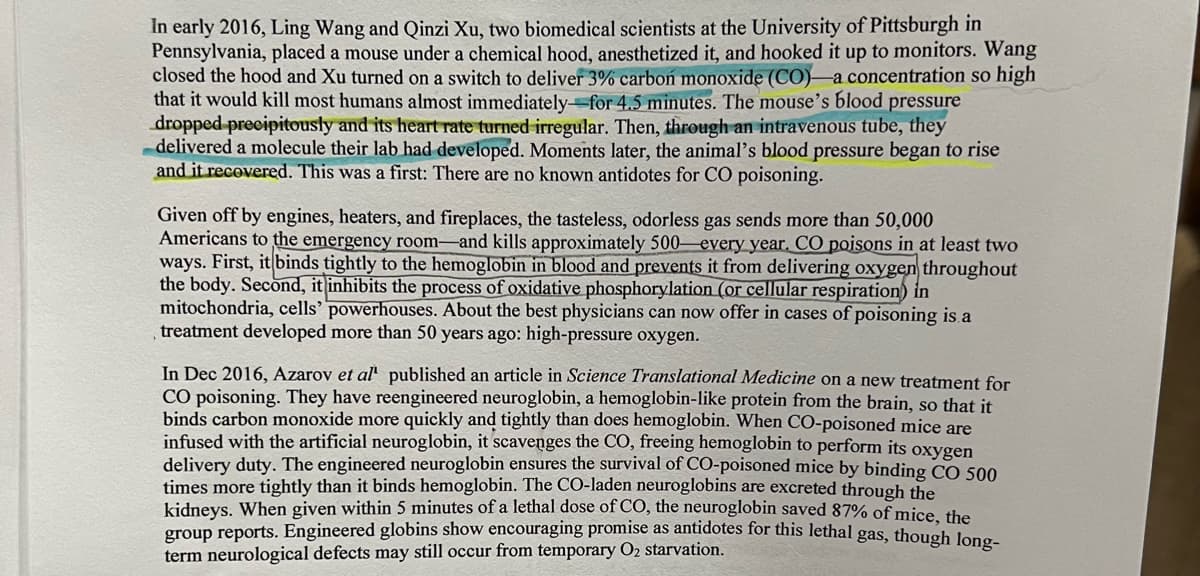how does high pressure O2 treat CO poisoning?
Human Heredity: Principles and Issues (MindTap Course List)
11th Edition
ISBN:9781305251052
Author:Michael Cummings
Publisher:Michael Cummings
Chapter11: Genome Alterations: Mutation And Epigenetics
Section: Chapter Questions
Problem 8QP: Bruce Ames and his colleagues have pointed out that although detailed toxicological analysis has...
Related questions
Question
how does high pressure O2 treat CO poisoning?

Transcribed Image Text:In early 2016, Ling Wang and Qinzi Xu, two biomedical scientists at the University of Pittsburgh in
Pennsylvania, placed a mouse under a chemical hood, anesthetized it, and hooked it up to monitors. Wang
closed the hood and Xu turned on a switch to deliver 3% carbon monoxide (CO)-a concentration so high
that it would kill most humans almost immediately for 4.5 minutes. The mouse's blood pressure
dropped precipitously and its heart rate turned irregular. Then, through an intravenous tube, they
-delivered a molecule their lab had developed. Moments later, the animal's blood pressure began to rise
and it recovered. This was a first: There are no known antidotes for CO poisoning.
Given off by engines, heaters, and fireplaces, the tasteless, odorless gas sends more than 50,000
Americans to the emergency room and kills approximately 500 every year. CO poisons in at least two
ways. First, it binds tightly to the hemoglobin in blood and prevents it from delivering oxygen throughout
the body. Second, it inhibits the process of oxidative phosphorylation (or cellular respiration) in
mitochondria, cells' powerhouses. About the best physicians can now offer in cases of poisoning is a
treatment developed more than 50 years ago: high-pressure oxygen.
In Dec 2016, Azarov et al published an article in Science Translational Medicine on a new treatment for
CO poisoning. They have reengineered neuroglobin, a hemoglobin-like protein from the brain, so that it
binds carbon monoxide more quickly and tightly than does hemoglobin. When CO-poisoned mice are
infused with the artificial neuroglobin, it scavenges the CO, freeing hemoglobin to perform its oxygen
delivery duty. The engineered neuroglobin ensures the survival of CO-poisoned mice by binding CO 500
times more tightly than it binds hemoglobin. The CO-laden neuroglobins are excreted through the
kidneys. When given within 5 minutes of a lethal dose of CO, the neuroglobin saved 87% of mice, the
group reports. Engineered globins show encouraging promise as antidotes for this lethal gas, though long-
term neurological defects may still occur from temporary O₂ starvation.
Expert Solution
This question has been solved!
Explore an expertly crafted, step-by-step solution for a thorough understanding of key concepts.
Step by step
Solved in 3 steps

Recommended textbooks for you

Human Heredity: Principles and Issues (MindTap Co…
Biology
ISBN:
9781305251052
Author:
Michael Cummings
Publisher:
Cengage Learning



Human Heredity: Principles and Issues (MindTap Co…
Biology
ISBN:
9781305251052
Author:
Michael Cummings
Publisher:
Cengage Learning

